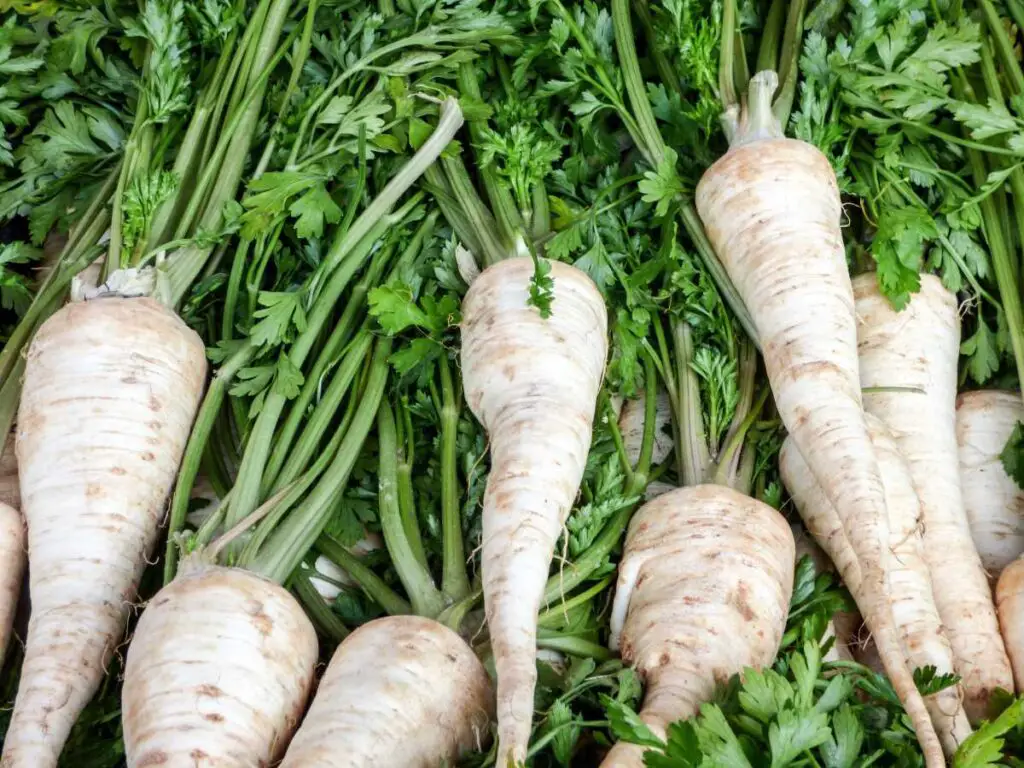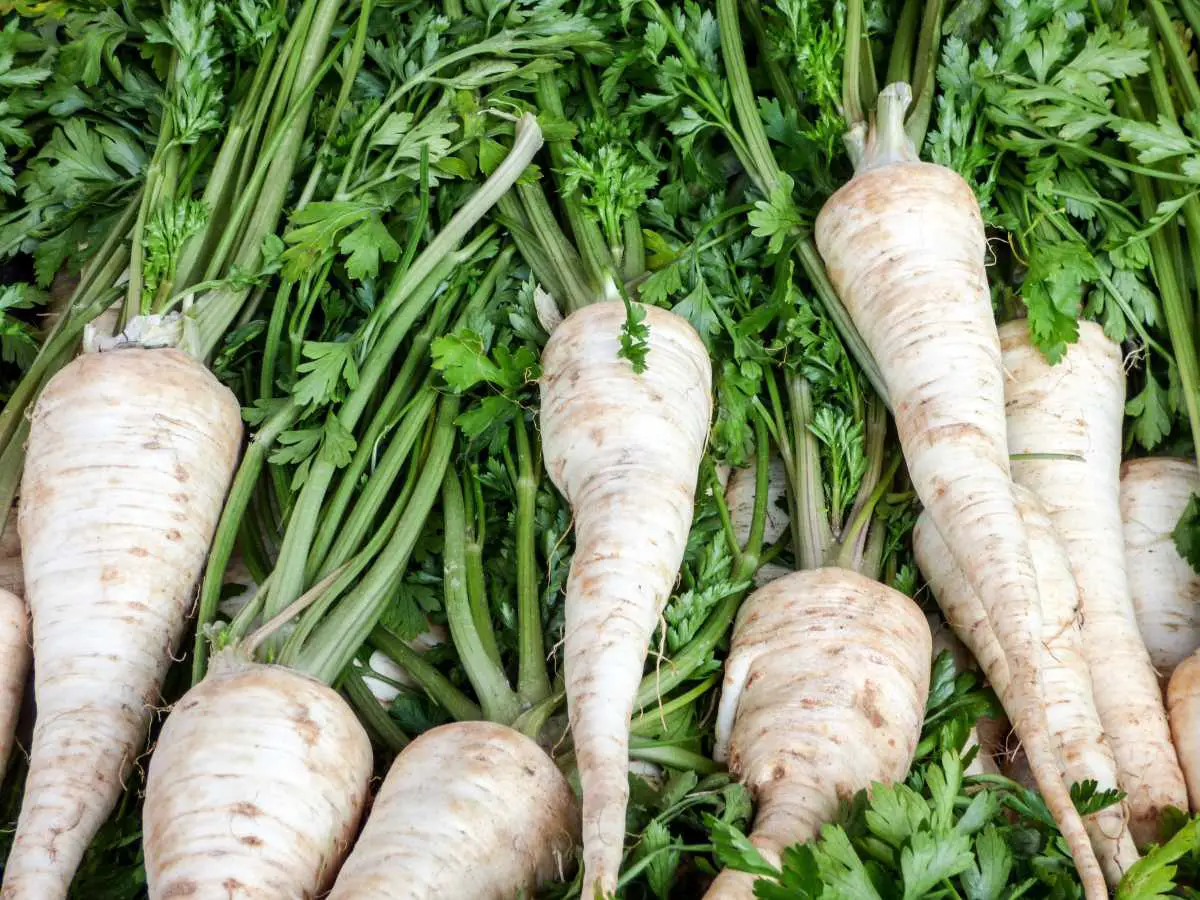In the world of root vegetables, parsnips often stand quietly in the background, overshadowed by their more popular counterparts like carrots and potatoes.
However, these humble cream-colored vegetables deserve a spotlight of their own. Bursting with flavor, versatility, and nutritional benefits, parsnips are a delightful addition to any diet.
In this article, we’ll explore everything you need to know about parsnips, from their origins to their culinary potential and health benefits.

Table of Contents
What is a Parsnip?
A parsnip (Pastinaca sativa) is a root vegetable closely related to carrots and parsley, belonging to the Apiaceae family.
This cream-colored, tuberous vegetable is often overlooked but holds a rich history and a distinct sweet, earthy flavor.
Characteristics of Parsnips:
Appearance:
Parsnips resemble large, pale carrots. They have a thick, tapered root that can grow up to a foot in length. The skin is typically creamy white or pale yellow, while the flesh is firm, dense, and off-white.
Flavor and Texture:
Parsnips offer a sweet, nutty flavor with hints of spice and a slight earthy undertone. Their texture, when cooked, becomes tender and almost creamy, making them ideal for various culinary preparations.
Cultivation and Origins:
Parsnips are believed to have originated in Eurasia and have been cultivated for centuries.
They were once a dietary staple in ancient civilizations such as the Romans and Greeks.
While they lost some popularity over time, parsnips have remained a key ingredient in traditional European cuisines.
Growing Conditions:
These root vegetables thrive in cool climates and are often harvested after the first frost. They require well-drained soil and ample sunlight to grow.
Parsnips have a long growing season, taking around four to six months to mature fully.
Culinary Uses:
Parsnips are incredibly versatile in the kitchen. They can be used in both savory and sweet dishes. Common cooking methods include roasting, boiling, steaming, or pureeing.
They make flavorful additions to soups, stews, casseroles, and can also be mashed or used as a standalone side dish.
Also Read: Broccoli Rabe: Side Effects, Nutrition, Benefits, Recipes & All.
Nutritional Profile of Parsnips
Parsnips are not only delicious but also pack a nutritional punch. Here’s a glimpse into their impressive nutritional profile:
Vitamins and Minerals:
Parsnips are a powerhouse of essential vitamins and minerals. They are particularly rich in vitamin C, an antioxidant that plays a vital role in supporting the immune system, collagen production, and overall skin health.
Additionally, they contain significant levels of vitamin K, essential for blood clotting and bone health, and vitamin E, contributing to antioxidant protection in the body.
Mineral-wise, parsnips boast potassium, a mineral crucial for maintaining healthy blood pressure levels and supporting nerve function.
Manganese, another mineral found in parsnips, aids in metabolism, bone development, and antioxidant defense mechanisms.
Meanwhile, magnesium and phosphorus contribute to bone health and energy metabolism.
Dietary Fiber Content:
Parsnips are an excellent source of dietary fiber, comprising both soluble and insoluble fiber.
Soluble fiber aids in lowering cholesterol levels and moderating blood sugar levels, making parsnips a good choice for individuals managing diabetes or looking to improve heart health.
Insoluble fiber promotes healthy digestion by adding bulk to stool and aiding regular bowel movements.
Antioxidant Content:
Beyond vitamins and minerals, parsnips contain various antioxidants, including flavonoids and polyphenols, which contribute to their potential health benefits.
These antioxidants help combat oxidative stress in the body, reducing the risk of chronic diseases and inflammation.
Health Benefits of Parsnips
1. Supports Digestive Health:
Parsnips are abundant in dietary fiber, a crucial component for maintaining digestive health. The soluble fiber in parsnips aids in softening stool and promoting regular bowel movements.
It also acts as a prebiotic, nourishing beneficial gut bacteria. This aids in maintaining a healthy gut microbiome, which is associated with improved digestion, nutrient absorption, and overall well-being.
2. Boosts Immune Function:
The high vitamin C content in parsnips plays a pivotal role in bolstering the immune system. Vitamin C acts as an antioxidant, scavenging free radicals and reducing oxidative stress.
This nutrient supports the body’s defense against infections and illnesses, contributing to a robust immune response.
3. Heart Health:
The combination of potassium and fiber in parsnips contributes to cardiovascular health. Potassium helps regulate blood pressure by counteracting the effects of sodium in the body, thereby reducing the risk of hypertension and related heart conditions.
Additionally, the fiber content aids in lowering cholesterol levels, further supporting heart health and reducing the risk of heart disease.
4. Antioxidant Properties:
Parsnips contain various antioxidants, including flavonoids and polyphenols, which offer protective effects against cellular damage caused by oxidative stress.
These antioxidants help reduce inflammation in the body and may lower the risk of chronic diseases such as heart disease, certain cancers, and neurodegenerative conditions.
5. Weight Management:
With a low calorie and high fiber content, parsnips can be beneficial for weight management. The fiber contributes to a feeling of fullness, which can help control appetite and reduce overall calorie intake.
Furthermore, their low glycemic index prevents rapid spikes in blood sugar levels, making them suitable for those aiming to maintain a healthy weight.
6. Nutrient Density:
Parsnips offer a spectrum of essential vitamins, minerals, and antioxidants in a low-calorie package.
Incorporating them into a balanced diet can help individuals meet their daily nutrient requirements while adding variety and flavor to meals.
By embracing the health benefits of parsnips and incorporating them into a diverse and nutritious diet, individuals can optimize their well-being and enjoy the advantages these root vegetables offer for overall health and vitality.
Parsnip Recipes
Now, let’s dive into the exciting culinary possibilities that parsnips offer. From comforting soups to crispy fries, parsnips can be used in various recipes, bringing a unique flavor and nutritional value to your meals.
1. Roasted Parsnips with Herbs
Ingredients:
- 4 large parsnips, peeled and cut into sticks
- 2 tablespoons olive oil
- 2 cloves garlic, minced
- 1 teaspoon dried thyme
- Salt and pepper to taste
Instructions:
- Preheat the oven to 400°F (200°C).
- In a bowl, toss the parsnip sticks with olive oil, minced garlic, dried thyme, salt, and pepper until evenly coated.
- Spread the seasoned parsnips on a baking sheet in a single layer.
- Roast for 25-30 minutes or until the parsnips turn golden brown and tender, flipping them halfway through cooking.
- Serve hot as a delicious side dish or snack.
2. Creamy Parsnip Soup
Ingredients:
- 4 cups chopped parsnips
- 1 onion, diced
- 2 cloves garlic, minced
- 4 cups vegetable broth
- 1 cup coconut milk or heavy cream
- 2 tablespoons olive oil
- Salt and pepper to taste
- Fresh parsley for garnish
Instructions:
- Heat olive oil in a large pot over medium heat. Add diced onions and minced garlic, sautéing until onions are translucent.
- Add chopped parsnips to the pot and stir for a few minutes.
- Pour in the vegetable broth, bring to a boil, then reduce heat and simmer for about 20-25 minutes or until the parsnips are soft.
- Using an immersion blender or transferring to a blender in batches, puree the soup until smooth.
- Stir in coconut milk or heavy cream, and season with salt and pepper to taste.
- Simmer for an additional 5 minutes, then serve hot, garnished with fresh parsley.
3. Honey Glazed Parsnips
Ingredients:
- 6-8 medium parsnips, peeled and sliced diagonally
- 2 tablespoons butter or olive oil
- 2 tablespoons honey
- 1 tablespoon balsamic vinegar
- Salt and pepper to taste
- Fresh chopped parsley for garnish
Instructions:
- In a large skillet, melt butter (or heat olive oil) over medium heat.
- Add sliced parsnips to the skillet and sauté for 5-7 minutes until they start to caramelize slightly.
- Drizzle honey and balsamic vinegar over the parsnips, stirring gently to coat evenly.
- Reduce heat to low, cover, and cook for an additional 10-15 minutes or until the parsnips are tender.
- Season with salt and pepper, sprinkle with fresh parsley, and serve as a delightful side dish.
These recipes showcase the versatility of parsnips and their ability to be transformed into delectable dishes that will tantalize your taste buds.
Experimenting with these recipes allows you to appreciate the unique flavor and culinary potential of parsnips in various cooking styles.
Side Effects
Parsnips offer numerous nutritional benefits, but there are a few considerations regarding potential side effects or issues associated with their consumption:
Allergic Reactions:
Individuals with known allergies to certain plants within the Apiaceae family (which includes carrots, celery, and parsley) might experience allergic reactions to parsnips.
Symptoms can include skin rashes, itching, swelling, or even more severe reactions like difficulty breathing in some cases. If you suspect an allergy, it’s crucial to seek medical advice.
High Sugar Content:
Parsnips contain natural sugars, and while they are relatively lower in sugar compared to some other root vegetables like carrots, they still have a moderate glycemic index.
Individuals managing diabetes or those following a low-carbohydrate diet should monitor their intake of parsnips to manage blood sugar levels effectively.
Goitrogen Content:
Like many cruciferous vegetables, parsnips contain compounds known as goitrogens, which might interfere with thyroid function in high amounts.
However, the levels of goitrogens in parsnips are generally low and typically not a concern for most people unless consumed excessively or in concentrated forms.
Oxalates:
Parsnips, like several other vegetables, contain oxalates, naturally occurring substances found in many plant foods.
In some individuals prone to kidney issues or kidney stone formation, high intake of oxalates might contribute to the formation of kidney stones.
However, moderate consumption as part of a balanced diet is usually not problematic.
Digestive Issues:
The high fiber content in parsnips might cause digestive discomfort, such as gas, bloating, or cramping, especially if an individual is not accustomed to consuming high-fiber foods.
Gradually introducing parsnips into the diet and ensuring adequate water intake can help mitigate these issues.
Overall, while parsnips are a nutritious addition to most diets, individuals with specific allergies or health conditions should exercise moderation and consult with a healthcare professional or a registered dietitian before significantly increasing their consumption, especially if they have concerns about potential side effects or interactions with their health conditions or medications.
Conclusion
Parsnips are an underrated gem in the world of root vegetables. Their exceptional flavor, nutritional benefits, and versatility in cooking make them a valuable addition to a balanced diet.
Whether roasted, pureed, or added to soups and stews, parsnips offer a unique culinary experience while providing numerous health advantages.
So, the next time you’re at the market, don’t overlook these ivory-colored roots. Embrace the charm of parsnips and savor their delightful taste in your meals for a wholesome and flavorful dining experience.
FAQs:
Parsnips have a distinct sweet, earthy flavor with a touch of nuttiness. They offer a slightly spicy and aromatic taste, akin to a milder version of carrots. When cooked, parsnips develop a tender texture and can be slightly creamy, making them versatile for various culinary applications.
No, parsnips are not the same as radishes. While both are root vegetables, they belong to different botanical families and have distinct appearances, flavors, and culinary uses. Parsnips are larger, cream-colored root vegetables with a sweet, earthy taste, whereas radishes are smaller, usually red or white in color, and have a crisp, slightly spicy flavor.
There isn’t a widely used alternate name for parsnips. They are commonly referred to as parsnips across English-speaking regions. In some cases, they might be colloquially called “white carrots” due to their resemblance to carrots and their pale color.
Parsnips and potatoes have distinct flavors despite some similarities in texture when cooked. Parsnips have a sweeter, more complex flavor profile compared to potatoes. While both vegetables can be used similarly in cooking and might have a mildly creamy texture when cooked, parsnips offer a unique taste with their sweet, nutty essence, distinct from the taste of potatoes.

